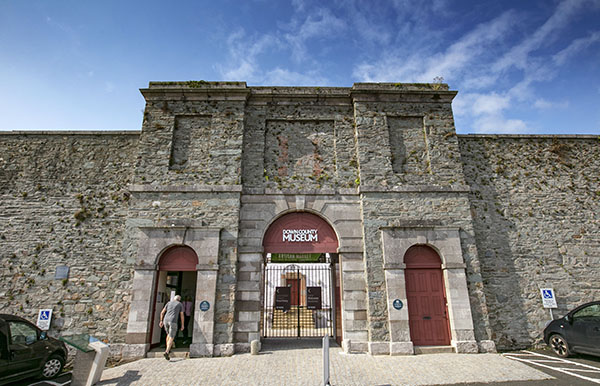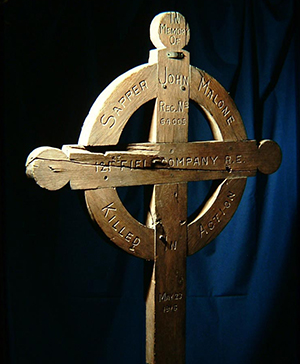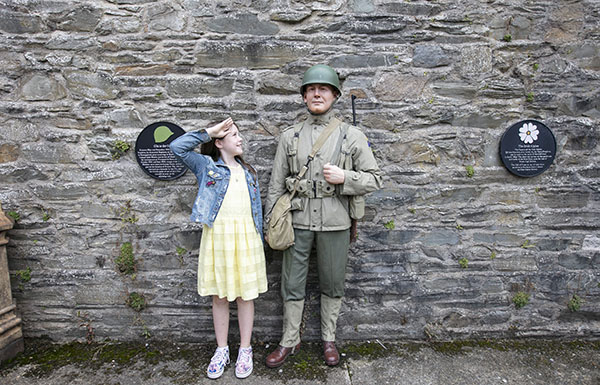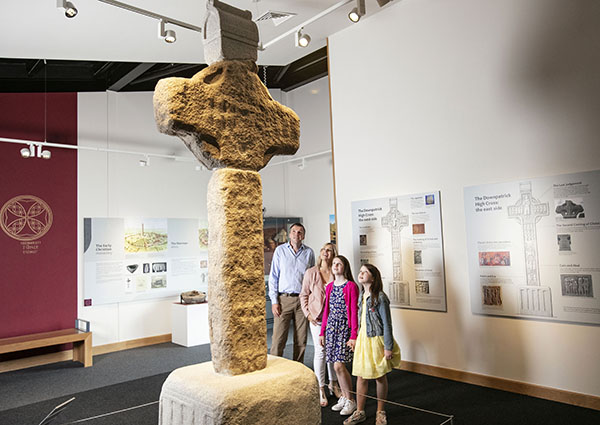MUSEUM EYE: Down County Museum
Published in Issue 1 (January/February 2020), Reviews, Volume 28Down County Museum
The Mall, Downpatrick, Co. Down
By Tony Canavan

Above: The building was originally the county gaol, which opened in 1796.
Down County Museum occupies a building of historical significance. It was originally the county gaol, which opened in 1796. Hundreds of United Irishmen were imprisoned here after the 1798 Rebellion and many were hanged from gallows at its entrance. In 1803 Thomas Russell (‘the Man from God Knows Where’) was also hanged here for his part in Robert Emmet’s failed rising. It consists of several buildings, with the main exhibitions housed in what is known as the Governor’s Residence.

Above: The First World War memorial cross of Sapper John Malone from Downpatrick, killed on 23 May 1916 and buried in Hamel Military Cemetery, Beaumont-Hamel, France.
The reception leads onto a courtyard where you are met by a life-size manikin of an American soldier from the Second World War, a reminder that US troops were stationed here in those years. You will also see a gallows in front of you but these do not date from the time when executions were carried out here. They are props that were used in the 2015 historical drama The Frankenstein Chronicles, starring Sean Bean, which was filmed here and in other locations in County Down.
Inside the Governor’s Residence, the permanent exhibition, ‘Down Through Time’, occupies two galleries. The first details the history of the county from ‘Prehistory to 1803’. As in the rest of the museum, there are objects in glass cabinets, information panels and interactive exhibits. It should be noted that the museum does its best to make history interesting for younger visitors. There are information panels directed at the younger audience and activities for them to try out. For example, in the first gallery you can try to reconstruct the pieces of a Neolithic clay pot. As well as this, the museum has a busy schedule of events for schools and an education officer on hand to help any visiting students.

Above: The reception leads onto a courtyard where you are met by a life-size manikin of an American soldier from the Second World War.
After explaining how the Down landscape was formed, the exhibition takes us through the first humans to settle in the county, the arrival of Christianity, the Vikings, the conquest by the Normans and so on. All this is aided by a time-line outlining major events and placing them in context. There are many interesting artefacts on display, such as flint tools, carved stones, bronze bells and a collection of gold bracelets that were discovered in the county. In ‘1470 to 1790s—land and power’ we are taken through the medieval period and the collapse of Gaelic society, which ultimately led to the Plantation of Ulster. Although not officially one of the Plantation counties, Down was settled by Scots and English incomers who left their mark on the landscape and established towns. Maps illustrate the change in ownership and land use. We are told that the eighteenth century was a time of relative peace and prosperity, and this is illustrated through costumes, portraits and a fine example of a long-case clock made by Tate of Down.
On your way to the next gallery, you will pass an exhibit about the gaol’s role in 1798 and the execution of Thomas Russell. Beyond this is the area devoted to the nineteenth and twentieth centuries. There are a wide variety of artefacts on display, covering a range of topics from everyday life and local industry to social changes and the two world wars. As elsewhere, a time-line guides you through the major events while information panels provide context and background. Among costumes from different eras, look out for a fine silk waistcoat from the nineteenth century made by local tailor Robert McDowell. In the display cabinets are newspaper cuttings and posters, toys, cutlery, whiskey jars, medals, coins and lots more, illustrating how people lived in these years.
There are two cabinets about Down and the two world wars, revealing how they affected the county and how local people were involved. While there is a display about the Ulster Volunteer Force and the Irish Volunteers, I was surprised that there was not more made of the Home Rule crisis and the establishment of Northern Ireland, surely momentous events in the county’s history. Nevertheless, you could easily lose yourself in this exhibition, which pulls together various strands of history and has a cornucopia of items. As we enter the modern era, for example, there are radios, televisions and phones, all of which heralded huge social change. Local pride is exhibited, too, in the wall where photographs of famous County Down people are displayed, such as Florence May Wilson (who wrote ‘The Man from God Knows Where’), C.S. Lewis and Sam Hanna Bell (of December Bride fame).

Above: The ancient high cross of Downpatrick, which was moved from outside Down cathedral, where it was being eroded by the elements, and reassembled inside the museum.
And that is not the end. Beyond the Governor’s Residence is the gaol, where you can visit cells. Here, too, are galleries for temporary exhibitions and an area devoted to the ‘Raising of the Cross in Down’, telling how the ancient high cross of Downpatrick was moved from outside Down cathedral, where it was being eroded by the elements, and reassembled inside the museum. The cross is placed in the context of Christianity in the county and other ecclesiastical sites there. Nearby is the Cathedral View Tearoom, where you can take a well-earned break after your trek through centuries of history.
Tony Canavan is editor of Books Ireland.
















